Path of War by Libertad!
Intro and Classes
Original SA post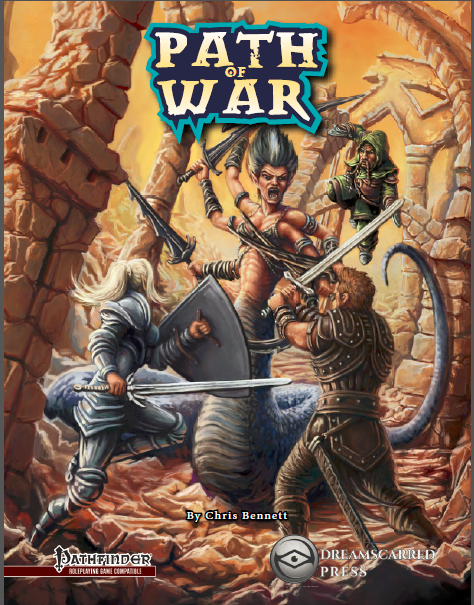
Back in the halcyon days of 2006, when the 3rd Edition line-up was coming to an end, the game designers were coming up with new subsystems to interact with the base D20 game. One of them was a new martial system which operated off of a per-encounter format, where characters could execute attacks and actions known as "maneuvers" a limited number of times much like Vancian casting. A lot of these ideas would later be adopted into 4th Edition, but the core system was first brought to the public as the Tome of Battle: Book of Nine Swords.
This sourcebook was divisive, to say the least. People who cared about game balance and loved martial archetypes saw it as the best thing to happen to noncasting fighters in what was probably the most unbalanced Edition so far. People who hated it viewed it either as an unwelcome intrusion of "Asian tropes" into D&D (which had the Monk class since the late 70s) or horribly overpowered drek. The truth of the matter is that the classes and maneuver system made for competent, versatile, and fun to play martial characters who did more than charge or full attack. Aside from a few problematic maneuvers such as White Raven Tactics or the infamous Ironheart Surge, Tome of Battle succeeded where so many other 3rd Edition Fighter fixes failed. It didn't bridge the gap between casters and noncasters completely, but it did make noticeable progress.
Among the GiantITP and Min-Max community, Tome of Battle homebrew was a common sight, and Chris Bennett (known by the username of ErrantX) devoted a lot of time and effort to making cool material online for others to use in their games. Eventually he was contacted by Dreamscarred Press, a 3rd Party Publisher famous for updating the Psionics Handbook to the Pathfinder Role-Playing Game. They wanted him to help them make their very own Tome of Battle for Pathfinder. As the original Wizards of the Coast book had no Open Game Content, they needed to start from scratch, but over the course of a year and a subscription service they persevered and brought the Path of War into the world.
You can see their design decisions and descriptions in the Introduction, which I'll repost here:
quote:
A Note From the Author
First off, I want to say: Wow! Second, I want to say: Thank you! Third, I want another resounding: Wow! This past year has been exciting. When Andreas reached out to me last year I thought it was a joke, like, this couldn’t possibly be real. My head was spinning! I started this on a dare from a friend over four years ago, and the Libram of Battle was born. This was a dream of mine since I was a young boy reading the original run of AD&D books my friend’s older brother had stashed in his closet. Since then, gaming has been a part of my life in a major way. I’ve always been writing new and different content, altering rules to better suit my style or the style of my group. Writing and designing game content has always been a thing in my life, and getting someone I respected for writing what I felt was the definitive rewrite of the psionics rules (they even made me like Wilder, something I never cared for!) to notice me? Too much!
But here we are. Through all the drama and ups and downs the last year has given me, the Path of War has marched on. I couldn’t do it alone. First and foremost, my wife Sabrina and family/friends were supportive beyond words. Then the amazing support of the folks on the Paizo forums, the GitP forums, and of course the Dreamscarred Press forums. My good friend Jade Ripley, and last but certainly not least Andreas and Jeremy themselves. I’ve made a lot of friends this last year, and I couldn’t have gotten here without the support of my people, online or here in person. You all mean the world to me, and I’m glad we’ve been able to get the Path of War out there. There’s more on the horizon, and the Path of War marches ever onward! Hope to see you all there!
Regards,
Chris “ErrantX” Bennett
Lead Designer for the Path of War
Dreamscarred Press
Introduction
quote:
Introduction
If you’ve played one of the martial classes, you might wonder why spellcasters get all the cool new toys. Sure, playing a fighter or rogue or monk can be fun, but they pretty much always have the same options - melee attack, ranged attack, full attack. There are occasionally things to make those interesting, such as cleave or grapple, but those options aren’t always the best option.
So why should spellcasters and manifesters get all the fun abilities? Path of War is here to give fun, but balanced, options to the martial classes so that roleplaying interactions aren’t the only time you get to do cool things with your character!
What is the Path of War?
To put it simply, the Path of War is a new way to look at martial combat in the Pathfinder Roleplaying Game. At its basic roots, the Path of War allows for martially-inclined characters to harness new abilities to aid them in combat. These new abilities are known as maneuvers, a specific technique that allows a martial disciple to enact a powerful attack, erect a defense against an attack, or improve his overall fighting ability or the abilities of others. By initiating these in combat, the martial disciple has a powerful edge that can even rival the powers of the spellcasters of the world.
Maneuvers are grouped into disciplines, with each discipline having a group of associated weapons that fit the use of that discipline. In addition, disciplines have an associated skill that is often used with many of the maneuvers themselves.
Once used, a maneuver is considered expended, not unlike a prepared spell for spellcasters. But where the difference between a spell and a martial maneuver lies is the martial disciple’s ability to recover that expended maneuver for use again and again over the course of the day.
All characters have the potential to learn these maneuvers, either by being a martial disciple or by being someone who has taken up martial training in addition to their class’ normal training. Martial disciples are those who have taken the stalker, warder, or warlord classes, and all others must learn martial maneuvers through training (such as by taking feats) or through specific training in their class (by taking up an archetype). Once learned, a character is forever a martial initiator, a warrior with skills beyond the abilities of most others of his kind, and the potential to master these arts lies before him along the Path of War.
A New Method Of Battle
So, there is a question that begs to be asked: Why make a new book of martial maneuvers? Well, from the days of 3.5, there was a certain book that did drive a wedge into many gaming tables as it challenged the philosophies of many who sat around it. “Was it okay to give fighters spells?” they’d say. Some would say yes, some would say no. Almost everyone had an opinion on the matter. Since the inception of the maneuver system in 2006, many people still use the parent book that inspired this work in the every day games and with good reason to; it was a great new set of options. Some didn’t like it, and as those who would agree with the utility of this book would say it’s because “they don’t want fighter to have nice things.” The Path of War is designed to give nice things to everyone and to bring a ton of new options to every class that relies on their strength of arms to survive an adventure.
The Path of War offers a number of new things that could fit into any campaign setting, from classes and archetypes, feats, items and monsters, to organizations that are fundamentally connected to cultures of martial disciples that have learned, developed, and spread disciplines of maneuvers to their members for mutual benefit. By adding the Path of War to your campaign, you’re adding an exciting wealth of new opportunities and options to the Pathfinder game system, breathing new life in to combat as well as into classic monsters that will suddenly have new tricks that veteran players will enjoy as much as new players. Martial disciples are here at last for the Pathfinder game system, and they’re determined to change the face of combat forever.
These folks are speaking my language.
Now, the Path of War does draw a lot of influence from Tome of Battle, but unlike the Psionics' Handbook it's not just a simple reprint. The classes, feats, and maneuvers are entirely new. And best of all, the game mechanics are entirely Open Game Content, meaning that they can be imported wholesale into other 3rd Party Products (and even Paizo, if they so desired). There's a list of all of them on the Pathfinder SRD already. If you like what you see and make extensive use of it in your games, be a nice person and toss Dreamscarred Press some money once you're financially able to do so; they're one of the few 3PP publishers out there who care about game balance and the quality of their work.
Maneuver Basics
If I just jump right into the classes, readers unfamiliar with the original Tome of Battle might be confused about certain things referenced. To that end, I'll be briefly going over Path of War's new martial mechanics. Basically it's like a "martial spellcasting" system: maneuvers are actions and attacks that can be used in combat a limited number of times before being replenished either via spending an action in combat (specifics depend upon class or feats) or until the encounter ends (in which case all of them are regained). A character's maneuver load-out can be changed through 10 minutes of activity like prayers, meditation, weapon drills or the like.
Stances, meanwhile, are always-active effects which grant benefits to the user, but only one can be maintained at a time. Maneuvers are further divided by what they do in combat (strikes are direct attacks, boosts are buff effects, and counters are triggered by an enemy action). Every maneuver and stance belongs to a martial discipline, a fighting school style whose abilities are thematically linked based upon common effects, philosophies, weapon groups and the like.
Those trained as martial disciples can pick and choose which ones to learn upon leveling up or gaining the right feats. A character can only "ready" a limited number of maneuvers they know to use in battles, and cannot use unreadied maneuvers in combat except under special circumstances granted by certain feats or class abilities. Each class in this book uses a specific mental ability score known as an initiation modifier, which help enhance the power of many maneuvers and stances.* Finally, Initiator Level represents general knowledge and experience of the art of war and determines the most powerful maneuvers and stances they can learn. A person's initiator level equals their character's level in a Path of War class + 1/2 levels or Hit Dice in any other class.
*I like this touch; it encourages the cerebral warrior as a valid and mechanically useful character concept.
Classes
There are three new 20-level base classes, all of which make use of the maneuver system outlined in this book. In addition to being skilled combatants, they all make use mental ability scores and have diverse skill lists to make them able to contribute to out of combat encounters as well (although not to the same extent as a dedicated caster). One thing to keep in mind here is that judging by this chapter alone the classes might not sound so stellar. Much like how the Druid and Sorcerer cannot be wholly analyzed by their class features alone, so too is the same for the Path of War classes. We'll be covering the maneuvers in their own chapter.
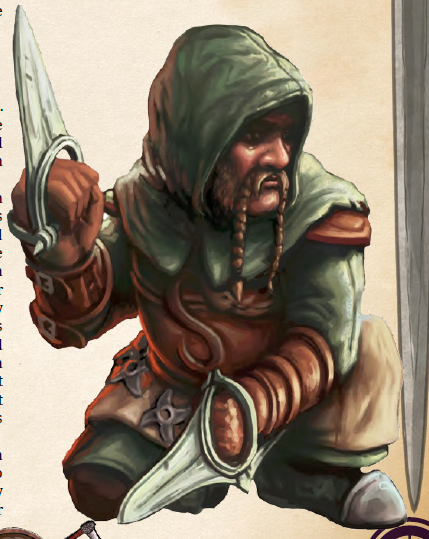
The Stalker is a mobile warrior who fights with a mixture of finesse, stealth, and mystic arts to bring low their foes. Ranging from slum-born rogues to members of esoteric orders of assassins, the stalker's art is a versatile one seen among all walks of life.
Stalkers are the weakest class in terms of hit dice and base attack (d8 and 3/4 level), but they have a versatile assortment of rogue-like skills and can learn and ready the largest amount of maneuvers of all the classes. They can learn maneuvers from the Broken Blade (unarmed combat), Solar Wind (missile and throwing combat), Steel Serpent (poison and pain-based anatomical attacks), Thrashing Dragon (daredevil acrobatic fighting), and Veiled Moon (mystical otherworldly trance state) disciplines. Their initiator modifier is Wisdom, and when they recover maneuvers in combat they gain a +4 armor class bonus as their ki defends their form as they re-center themselves.
A stalker's class features include a Ki Pool, a limited resource value which spent allow the stalker to gain insight into their opponent. At first grants bonus on Perception and Sense Motive, but can eventually allow the Stalker to apply a bonus to saving throws as an immediate action, apply their Deadly Strike damage on all strikes made against a single opponent, and even the ability to trade readied maneuvers around!
The Stalker also gains Deadly Strike, which is a lot like Sneak Attack except that it activates for a number of rounds equal to their Wisdom modifier after they score a critical hit against a target. I sort of have mixed feelings on this: on the one hand, it pretty much requires any Stalker build to become a crit-focused combatant with certain weapons. On the other hand, the Stalker doesn't need to be hiding in order to use it and it can work by spending Ki.
Other class features include Combat Insight, which over a period of levels allows the Stalker to add their Wisdom to armor class and rolls to confirm critical hits, as well as blindsight and uncanny dodge among other things; a Dodge bonus to armor class; Blending which grants a bonus to stealthy skill as the stalker hones their ki; Dual Strike at 10th level which allows them to use two strikes at once as a full-round action; and Retributive Ki as the capstone 20th level class feature, which allows him to initiate a martial strike whenever they're targeted by an enemy's spell, attack, or harmful ability. What's coolest about this last one is that it has the same range as the enemy ability, meaning that an echo version of the Stalker rushes forth to deliver the attack if they're well out of reach!
But the real meat of the class features are Stalker Arts. Stalker Arts are cool things a Stalker can learn at 1st, 3rd, and every 4 class levels thereafter which represent learned talents, fighting arts, and near-supernatural abilities. There's 19 in all and I won't list them all, but a few of the cooler ones include Concealed Recovery (the stalker's form becomes shimmering and gains concealment while recovering maneuvers), Deadly Ambush (may now apply Deadly Strike against flat-footed opponents), Ki Vampirism (gain 1 ki point when you knock an opponent to 0 hit points), Murderous Insight (spend a ki point as a swift action to roll twice and take the better roll for a single attack), Phantom Reach (spend 1 ki point to turn a melee attack into a ranged attack by manifesting it as a phantom echo). Some pretty cool stuff here!
Libertad's Thoughts: The Stalker class can just as easily serve as a replacement for the monk or rogue in terms of both game mechanics and flavor. In spite of their lightly-armored mobile nature, the multiple ways of gaining armor class and concealment in combat does a fine job of turning away attacks.
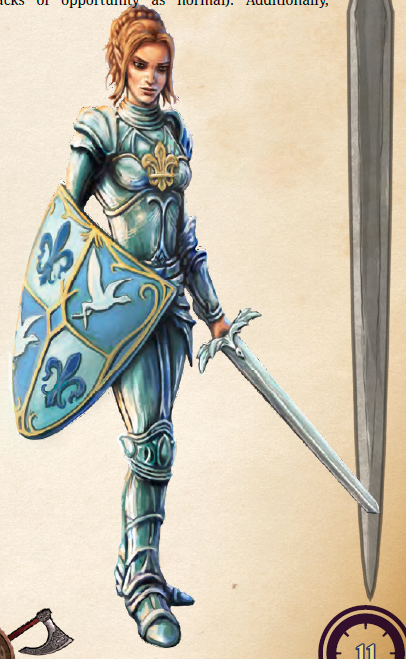
Part tank, part genius tactician, the Warder uses their mental acumen to defend others and foil enemy maneuvers. They're d12 hit dice and heavy armor and shield proficiency makes them tough as nails, and their skill list includes several social and knowledge-based skills to better cement the concept of "leader of men" and "master strategist." They range from chivalrous knights to holy warriors, and make for natural champions of nations and causes.
Their initiation modifier is Intelligence, and when she recovers her maneuvers in combat as a full-round action she sets up a defensive perimeter around herself which make it hard for enemies to get past them. This class feature is known as Defensive Focus and does a number of things, such as granting them a greater reach for provoking attacks of opportunity (5 foot increase per 5 levels!), turns threatened squares into difficult terrain, and adds her Intelligence bonus to her Combat Maneuver Defense. This is really great because it creates a semi-large radius around the warder which allows them to attack passing opponents. Give a warder a polearm and a size enlargement spell, and you'll be hitting foes as far away as 20, even 35 feet!
Warders gain access to the Broken Blade, Golden Lion (leadership teamwork tactics), Iron Tortoise (shield and phalanx fighting), and Primal Fury (animalistic, hunter-like natural attacks) disciplines. In addition to Defensive Focus, their class features include Combat Reflexes as a bonus feat which uses Intelligence instead of Dexterity; Aegis, which grants bonuses on Armor Class and Will saves to nearby allies (inspiring presence);
Armiger's Mark brings to mind the 4th Edition Fighter, where the enemy must direct hostilities to the Warder or else bad things happen to them. The Armiger's Mark is a limited use-per-day well-placed attack or taunt which forces the enemy to directly engage her or suffer a massive penalty to attack rolls (-4 to -8 based upon Warder's level) and Arcane Spell Failure. At higher levels she can affect multiple opponents at once with an Armiger's Mark as an area attack.
Tactical Acumen, which represents scholarly knowledge of historic battles and quick wits which add her Intelligence modifier to Reflex saves and initiative (replacing Dexterity in the latter case); Extended Defense which allows the Warder to initiate a counter maneuver as a free action.
Adaptive Tactics, which allows the Warder to spend one use of Armiger's Mark to switch out up to her Intelligence modifier in readied maneuvers during combat.
A lot of the later class features are defensive abilities such as Stalwart (which allow her to reduce the effects of a harmful effect which targets Fortitude or Will to no effect at all) and Steel Defense (which redirects a killing blow to target a held shield or armor instead). The 20th level captsone ability is Deathless Defense, which is activated by expending 2 uses of Armiger's Mark. Once activated, the Warder enters a resolute juggernaut-like state of iron will: they can maintain Defense Focus as a move action, gain the benefit of her own aegis, is unable to die due to hit point damage, and is immune to mind-affecting effects (their devotion's so strong). Deathless Defense's duration is one round plus one per additional use of Armiger's Mark, and once ended the Warder's exhausted and must rest for 8 hours before being able to use it again.
Libertad's Thoughts: The concept of a brainy armor-clad tank is a novel one I honestly can't remember seeing elsewhere in D20 products. I like the battlefield control and debuff aspects of the class. The teamwork tactics of the Golden Lion can let her allies do cool stuff, and the charge-based maneuvers of Primal Fury can give them some much-needed mobility. I don't understand how the Primal Fury fits thematically, but I ain't complainin'.
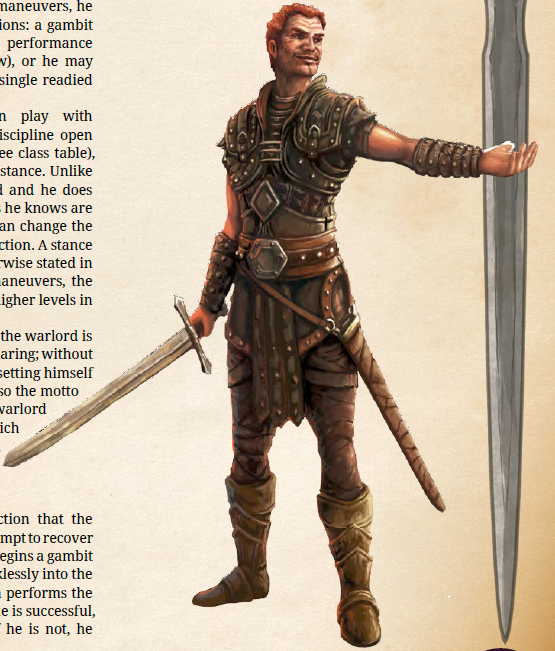
The Warlord is a fight-loving daredevil who lives for the thrill of danger. Their recklessness makes them a sort of lovable scoundrel, and their presence on the battlefield can provide inspiration to others by lifting their spirits. With a d10 hit dice and proficiency in martial weapons and medium armor, they're fighters through and through. Their skill set is lackluster in comparison to his two class counterparts, but is still leagues above the Pathfinder Fighter by including things such as Acrobatics, some Knowledges, Perception, and Sense Motive among other things. If you read Order of the Stick or the Three Musketeers, then they're pretty much the Dashing Swordsman writ large.
A warlord's initiation modifier is Charisma, and their methods of recovering maneuvers is more restrictive: spend a standard action to regain a single readier maneuver, or perform a Gambit and recover a number of maneuvers equal to his Charisma modifier if said Gambit is successful. Warlords gain access to maneuvers from the Golden Lion, Primal Fury, Scarlet Throne (noble duelist), Solar Wind, and Thrashing Dragon (wild and reckless two-weapon fighting) disciplines.
The warlord's major class feature is the Warlord's Gambit. Warlords are at their best when they're daring, so they gain actual benefits when performing riskier-than-usual actions in combat. There are several Gambits a warlord can learn, learning more over the progression of levels. Each Gambit is activated as a swift action and requires a certain action in combat such as a trip, a charge, a ranged attack on a moving mount, etc, which is known as a Risk. If the warlord is successful, they gain benefits known as a Reward in addition to regained maneuvers. On a failure they suffer the penalties known as a Rake, which are universal as a -2 penalty on all d20 rolls for one round. However, a warlord regains one maneuver even on a Rake, so it's not all bad.
There are 15 gambits, and a lot of them grant some kind of bonus equal to the warlord's Charisma modifier, and quite a few benefit the warlord's allies in some way. A few of the more interesting gambits include Deadeye Gambit, activated by a successful called shot which grants temporary hit points to nearby allies as the attack fills them with renewed spirit; the Gatecrasher Gambit, activated by a successful bull rush which imposes a penalty on all 20 rolls equal to warlord's Charisma mod as they're so rattled by the attack; and Sweeping Gambit, activated by a successful trip attack which grants an immediate attack of opportunity against said foe with a Charisma bonus added to the damage roll.
I really like the Gambit system; it gives good in-game incentives in the form of bonuses for the party and debuffs on the enemy. Furthermore, it encourages the Warlord to perform unorthodox tactics in combat which are rarely if ever used by Pathfinder players (let's face it, nobody really uses overrun).
Tactical Presence is the warlord oozing raw Charisma, aiding himself and his allies on the battlefield in an effect which is a throwback to the Marshal Auras from 3.5's Miniatures Handbook. By activating a certain Presence, the warlord and allies within 30 feet may add his Charisma modifier to certain saves and even temporary hit points.
Warleader is a limited-use-per-day ability which allows the warlord to share the benefits of a Teamwork feat with all allies within 30 feet, even if they don't meet the prerequisites.
Force of Personality adds the warlord's Charisma modifier in addition to Wisdom on Will saving throws (doesn't stack with Paladin's Divine Grace). Tactical Flanker is another Charisma-based benefit, in that it allows the warlord and an ally to substitute his Charisma modifier for the +2 bonus on attack rolls for flanking an opponent. Tactical Assistance does the same thing, but for Aid Another actions instead and is gained at 12th level.
If Stalkers could activate two Strikes, and the Warder's the master of Counters, then the Warlord's game is Boost, where they can activate two of them at once with the Dual Boost class feature gained at 6th level.
The warlord's later class feature mainly involve enhancing existing class features. Dual Tactical Presence allows him to maintain two Presences at once; Warlord's Presence activates three at a time; Master Warleader allows him to activate Warleader as a swift action; and the capstone ability at 20th level is Dual Stance, which allows the Warlord to gain the benefits of two different stances simultaneously.
Libertad's Thoughts: Like the Stalker and Warder, the Warlord's mechanics are nifty and fun, and the overall flavor text of an arrogant yet personable warrior is great role-playing opportunity.
Thoughts So Far: Path of War is shaping up to a promising start. I like how Dreamscarred made each class reliant upon mental as well as physical acumen; their class features, combined with maneuvers and stances, provide no shortage of cool tricks for players to choose from in combat.
Next time, Chapter 2: Skills and Feats!
Edit: Important note I forgot to add: A Warlord may use a maneuver as part of a Gambit if doing so would help accomplish the action, but he can't recover the maneuver he just expended. This is important, because it potentially allows the warlord to do a damaging attack in addition to bull rush/trip/etc. It also prevents a "use maneuver, gain maneuver" loop by forcing the warlord to effectively cycle between different maneuvers.
Skill and Feats
Original SA post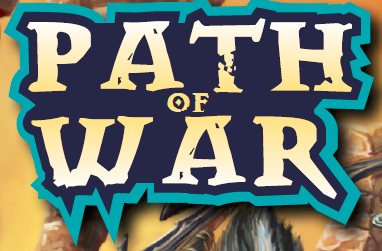
Chapter Two: Skills & Feats
Or more accurately, Skill & Feats. This chapter's rather short yet brimming with feats all over the place.
The only new skill is Knowledge (Martial), which can help you identify maneuvers, determine disciplines known by a martial disciple, and all-purpose lore about famous battles and mighty warriors and fighting styles and all that jazz. As is to be expected, it's a class skill for the Stalker, Warder, and Warlord, although it doesn't specify if existing classes gain access to it. I'd assume that folks who get Knowledge (all skills) gain it as well.
Now we get to our feats, 35 in total. I won't cover them all, instead highlighting a few of the more interesting ones:
Advanced Study grants you two new known maneuvers of disciplines known to your martial class. Extra Readied Maneuver is similar in that it, quite simply, allows you to ready one additional maneuver than normal for your class level.
Extended Mark doubles the duration of the Warder's Armiger's Mark, effectively double her Intelligence modifier. A very useful feat.
Naturally we have feats like Extra Gambit, Extra Ki, Extra Marks, and Extra Stalker Art which expanded uses of the new class' resources and can all be taken multiple times. Extra Stalker Art in particular's pretty good.
Deadly Agility is our "substitute Dexterity modifier to damage rolls" feat. This is quite interesting as Paizo's Advanced Class Guide attempted it's own "Dex to damage feat. Let's contrast and compare:
The Path of War one:
quote:
Deadly Agility [Combat]
You have learned how to use your agility to greater purpose in battle.
Prerequisites: Weapon Finesse, base attack bonus +1
Benefit: You may add your Dexterity modifier in place of your Strength modifier when wielding a light weapon or a weapon that gains the benefits of the Weapon Finesse feat (such as the rapier) when determining additional damage inflicted upon a successful attack. This modifier to damage is not increased for two-handed weapons, but is not reduced for off-hand weapons.
And the Paizo one:
quote:
Slashing Grace
You can stab your enemies with your sword or another slashing weapon.
Prerequisite(s): Dex 13, Weapon Finesse, Weapon Focus with chosen weapon.
Benefit: Choose one kind of one-handed slashing weapon (such as the longsword). When wielding your chosen weapon one-handed, you can treat it as a one-handed piercing melee weapon for all feats and class abilities that require such a weapon (such as a swashbuckler's or a duelist's precise strike) and you can add your Dexterity modifier instead of your Strength modifier to that weapon's damage. The weapon must be one appropriate for your size.
Clearly, Deadly Agility's the superior choice. Applies to more than one kind of weapon, easier prerequisites, off-hand weapons deal full Dex modifier damage.
On a similar note, Double Weapon Finesse treats double weapons as light weapons for Weapon Finesse and Two-Weapon Fighting, so your Dex-focused warrior can whip around Darth Maul-style with a two-bladed sword.
Deadly Pairing requires access to the Deadly Strike class feature and a Steel Serpent stance, but it allows you and a flanking ally to increase the critical threat range of each other's weapons by 1 (not multiplied by feats or spells, instead added after the multiplication).
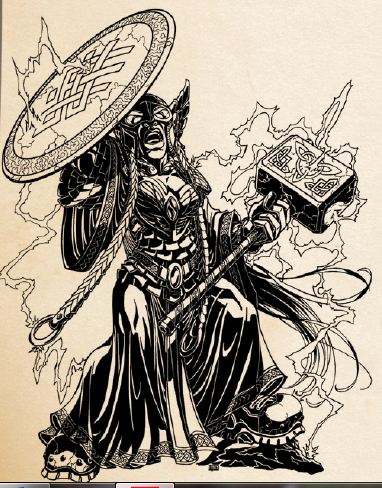
Defense Expertise allows you to add your shield bonus to your touch armor class and its enhancement bonus to Reflex saves, a nice feature for heavily-armored warriors.
Greater Unarmed Strike increases the base damage dice of your unarmed strike determined by your Base Attack Bonus. It's pretty lackluster in comparison to the Monk, ranging from 1d4 at +3 to +6 BAB to 1d10 at +15 or higher. As Improved Natural Attack no longer applies to unarmed strikes in Pathfinder, I can see how this is a workaround, but it wouldn't be so game-breaking to up the damage dice a little; greatsword-wielding fighters already deal more damage without any feat investment, for example.
Guard's Glare is a cool Warder feat which makes any demoralized/frightened/panicked/etc creature under the effect of an armiger's mark unable to move in a direction away from you unless they succeed on a Will save (new save once per round). This is great for the purposes of battlefield control. In fact, it appears that the Warder gets the most love comparatively feat-wise: Powerful Mark increases the penalty by 2 for Armiger's Mark and the Save DC for the area of effect application, and Take the Blow allows a Warder to expend an armiger's mark use as an immediate action to force an enemy's attack to target them instead of an ally within the Warder's threatened area.
Martial Charge allows one to initiate a strike instead of a normal attack at the end of a charge. Tactical Rush is another mobility-based feat which allows you to move up to your base speed as a swift action once per encounter.
The Martial Training feat tree is numbered I through VI, and it allows members of the non-Path of War classes to learn maneuvers and stances of a single discipline. The discipline's associated skill is now a class skill, and the skill's ability score (Dexterity for Acrobatics, for example) is considered their initiation modifier for maneuvers learned from this feat. Their expertise is inferior to true practitioners such as the Warlord, and their initiation level is equal to half their character level + their initiation modifier.
Serene Stride requires access to a Ki Pool and allows you to ignore the Acrobatics and movement penalties on difficult terrain and walk on water Jesus-style.
Weapon Group Adaption is a good, versatile feat where you choose one weapon group barring siege weapons (bows, flails, heavy blades, etc) to be considered associated with a chosen discipline. So if your assassin character concept involves a nifty combination of polearms and the cloak-and-dagger arts of the Steel Serpent, your dream can come true!
Libertad's Thoughts: Although we covered only 2/3rds of the feats, I looked at them all and I can safely say that each of them is useful on its own for a wide variety of character concepts. There are no nigh-useless, underpowered, or highly situational feats here, which is something I can't say for most 1st and 3rd Party Pathfinder products.
Next time, Chapter 3: Systems & Use, the meat and bones of the game mechanics underlying Path of War's maneuver system!
Systems and Use
Original SA post
*Note: I was wrong in the Warlord's detail: they can recover expended maneuvers equal to their Charisma modifier on a successful Gambit (minimum 2), 1 on a failed one.
Chapter Three: Systems and Use
This section is the basic rundown of how Path of War's martial system works, and what all the terminology means. Some of it is what we covered earlier, some things are new to this chapter.
Martial Abilities goes over the differences between maneuvers and stances, as well as the 3 different kinds of maneuvers: boosts, counters, and strikes. The in-game reasoning for why maneuvers are limited-use is because the character expended a portion of their energy, they're out of position and can't resume the necessary posture, or their mental focus must be regained.
Readying Maneuvers is basically equivalent to a wizard preparing spells: characters must spend 10 minutes preparing a certain number of maneuvers they know to use in future encounters, and cannot leave maneuver slots open like clerics and wizards can do. A character has access to all of their stances in an encounter and can adapt between any of them.
Initiating Stances and Maneuvers refers to the action necessary to use the maneuver or stance in combat. Basically a swift/move/etc action, and unlike spells characters don't need to speak in order to use it (unless the maneuver specifically says otherwise). Stances are always initiated as a swift action.
In general, stances and maneuvers do not require Concentration to use or maintain and do not provoke an attack of opportunity unless it says otherwise in the description. However, enemy interference (such as readying an action, disarming a necessary weapon for a discipline, etc) can foil a maneuver which is still considered "used." In most cases, a character must be able to move freely in order to initiate maneuvers and stances, meaning a grapple can shut you down.
Libertad's Notes: I have mixed feelings regarding grappling being a maneuver-foil. There are so many huge beasts in Pathfinder who can overshadow PCs own modifiers that this can end up a really common hindrance, doubly so that so many maneuvers are melee-based.
Initiator Level is simply like a Caster Level. It determines your overall martial skill, and what level maneuvers and stances you can access. Much like wizard spells, maneuvers are grouped into levels 1 through 9; in order to use 1st level maneuvers, you must have an initiator level of 1, for 2nd level maneuvers your initiator level must be 3, 3rd level maneuvers for 5, and so on and so forth.
Much like Tome of Battle, Path of War's very dip-friendly: your Initiator Level is equal to your level in a martial class (Stalker/Warder/Warlord) + 1/2 your levels in all other classes. However, multi-classing between the three martial classes results in variant initiator levels for them: a 9th level Stalker/5th level Warlord treats his Initiator Level as 11 for Stalker maneuvers and 9th for Warlord maneuvers. Maneuvers of differing classes are readier and performed separately.
Resolving a Stance or Maneuver discusses the effects of finishing said maneuvers' effects. It's a basic description of attack rolls (offensive maneuvers which target an opponent, even with a save, are considered attacks), bonus types (untyped bonuses always stack), and actions during a maneuver (a description providing the type of action necessary during the maneuver.
Now we discuss the Recovery of Expended Maneuvers. Maneuvers are recovered either via a special action such as a class feature, or at the end of an encounter. Instead of being based on a per-day limit, maneuvers get recovered at the end of combat.
In the original Tome of Battle, an "encounter" was vaguely worded so that the recovery of maneuvers was up to DM Fiat. In Path of War, an "Encounter" is defined as a period of time when initiative begins (starting with the surprise round, if any) to the last initiative ended and after a total time of one minute has elapsed without combat resuming. Basically, if a party kills 5 goblins and 1 minute elapses, maneuvers are recovered. Same if the party flees the encounter and the goblins don't give chase, and they don't encounter any other opponents within 1 minute.
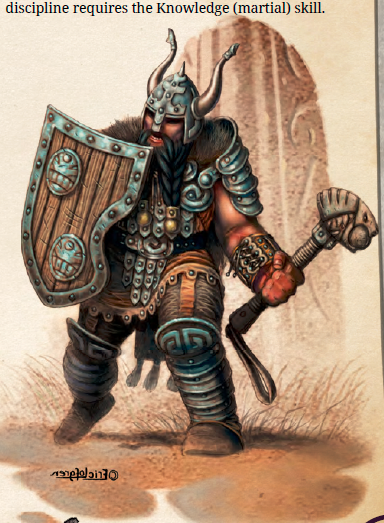
Martial Abilities and Magic discuss the potential interaction with spells. The vast majority of maneuvers and stances are extraordinary abilities, which means that they are completely non-magical in nature (Pathfinder's RAW mentions that extraordinary abilities can break the laws of physics as well understand them, so it's not just this book). A few of them are supernatural abilities and obey all the rules as such, but maneuvers and stances are never spells or spell-like abilities. The use of a martial maneuver are generally instantaneous and not long-lasting, and thus obvious to observers. However, people can identify certain ones via Knowledge (Martial). Bonuses and penalties of spells and stances/maneuvers can stack with each other, provided that the bonuses don't overlap (ex. an Insight bonus from a Stance won't stack with an Insight bonus from a spell).
Path of War also presents two new damage types, Profane and Sacred. Profane damage are energies powered with sheer Evil and deal 1.5 times as much damage on good-aligned characters and outsider with the [Good] subtype. Sacred damage is the same mechanics-wise, but it's holy and affects evil-aligned characters and [Evil] outsiders.
Stance and Maneuver Description
This section provides us with a standard format for stance and maneuver entries. We also get a more in-depth, in-game description of the various martial disciplines here for the first time!
You might notice that two disciplines, Black Seraph and Silver Crane, are not granted by any of the three classes. This is intentional; the disciplines are learned by joining a respective Martial Tradition (organization) detailed in Chapter Seven.
Black Seraph is a cruel art passed down from fiendish tutors as a way of enticing mortals into serving them. This disicpline focuses on powerful two-handed strikes, infliction of pain, and dirty fighting. Its associated skill's Intimidate, and the associated weapons are axes, flails, and pole arms.
Broken Blade's origins lie in a swordsman whose signature weapon was sundered on the field of battle. He had a flash of insight, realizing that his training regimens made his own body a deadly weapon. Ever since it's been taught in monasteries and passed down from tutor to pupil. Its associated skill is Acrobatics, and the associated weapons are close, monk, and natural. Yes, you can use bite and claw attacks in addition to unarmed strikes with Broken Blade!
The discipline of the Golden Lion is a practice passed between war leaders, generals, chieftains, and militia leaders over generations to bring their fighting units into a cohesive whole. It's mostly beneficial to warriors with allies, and the maneuvers and disciplines are geared towards indirect aid. Its associated skill is Diplomacy, and the associated weapons are heavy blades, hammers, and pole arms.
Iron Tortoise arose from the need to protect oneself and one's allies during wartime. Phalanx fighters knew that their shields were just as great a boon to themselves as to the soldiers standing next to them, and the discipline relies upon a shield to foil enemy actions. Its associated skill is Bluff, and the associated weapons are axes, heavy blades, and close weapons.
Believed to be the oldest of all disciplines, Primal Fury combines cold rage with calculated intellect for remorseless warfare. Its earliest practitioners were hunters who emulated the actions of great predators and spread their teachings everywhere. Its associated skill is Survival, and the associated weapons are axes, heavy blades, and hammers.
Scarlet Thrones owes its invention to duelist aristocrats who realized that the realities of war made one-on-one matches impractical. This brief description's pretty great:
quote:
Regal and unflinching, a practitioner of Scarlet Throne owns any field of battle he walks upon, for it is his court and there he rules, painting his chambers red with the blood of his enemies.
Its associated skill is Sense Motive, and the associated weapons are heavy blades, light blades, and spears.
Silver Crane is the celestial counterpart to Black Seraph. It can only be learned and used by those of good alignment inspired by angels and other heavenly outsiders. Its stances and maneuvers focus on insight and combat-predictions to counter-act the forces of evil. Its associated skill is Perception, and the associated weapons are bows, hammers, and spears.
Solar Wind originated among the archers of the windy plains, who used the terrain to deliver deadly force across vast distances. Its maneuvers and stances include ricochet shots, precision strikes, ammo which can be conjured from phantom force or hit multiple opponents, and counters which shoot enemy projectiles out of the sky. Its associated skill is Perception, and its associated weapons include bows, crossbows, firearms, and thrown. All maneuvers of the discipline require the use of a weapon from these groups, and thrown weapons which can be used for melee must be used for their intended ranged capacity.
Steel Serpent dates back to ancient times, hailing from those who practiced in the dark of night, belonging to hidden organizations who valued the art of a swift, clean kill. Stealth, trickery, poison, and the knowledge of anatomy are important features of this discipline. Its associated skill is Heal, and the associated weapons are light blades, close weapons, and monk weapons.
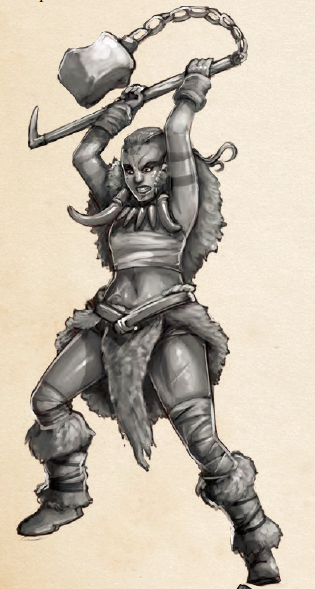
Thrashing Dragon is popular among both strict aesthetics and daredevils for its grace and quickness. Its practitioners are mostly two-weapon fighters with extensive acrobatic and athletic training. Its associated skill is Acrobatics, and the associated weapons include close weapons, light blades, and double weapons.
Veiled Moon is a strange and esoteric discipline, practitioners appear to be "half-in, half-out," living in two worlds at once. This is not far from the truth, as Veiled Moon makes use of connection to the Astral and Ethereal planes for greater harmony between the spirit and natural worlds. Its maneuvers are the most supernatural of the bunch, including teleportation effects, assuming incorporeal form, and even being able to affect said forms. Its associated skill is Stealth and the associated weapons include light blades, double weapons, and spears.
The rest of the section talks about basic stuff, like the range of the attack, descriptors for types (fire, teleportation, evil, etc), the maneuver/stance's level, and the action necessary to activate it. What's interesting is that some maneuvers and stances have prerequisites, usually a minimum number of known maneuvers of that same discipline before it can be learned.
We also get a run-down on boosts, counters, strikes, and stances. Interestingly, boosts and stances always require a swift action to activate, while counters are immediate actions (meaning that they're activated on an offending enemy's turn when they perform a necessary action). Boosts which apply to attacks only apply to attacks made within the round it was initiated. Counters can be used against critical hits unless the threatening roll was a natural 20.
Strikes are almost always standard or full-round actions which is resolved with an attack roll, damage modifiers, and base weapon damage. Damage from strikes can be added onto a critical hit, but are not multiplied. As strikes require a specific form of attack, users cannot benefit from spells and effects that grant extra attacks (such as haste) while making a strike. Additionally, actions such as disarm and trip cannot be combined with strikes unless it says otherwise in the description.
Also, Vital Strike and its subsequent feat chain cannot be used in conjunction with strikes. However, boosts and counters can be used in conjunction with it. The rationale is that Vital Strike requires the use of a standard action to activate it, making it very much like a martial maneuver.
Stances can be switched from one to another in the same round as a swift action, allowing for some creative combinations in a combat round. They also count as maneuvers for the purposes of meeting prerequisites for higher-level maneuvers, feats, and prestige classes. Stances end if the user is rendered helpless (immobile).
Our chapter ends with discussion Learning New Stances and Maneuvers. It explains that the per-level learning is assumed to be the result of practice and training between adventures and while resting, as well as knowledge gained from honing their abilities in dangerous situations.
It's possible for martial disciples to learn new stances and maneuvers independent of leveling up, but that's up to the DM. Should this be permitted, the training regimen takes a minimum number of days equal to 3 x the maneuver/stance's level, as well as a fair cost to represent the resources used for the training (500 gold pieces per level is the default). At the end of the training, they make a Knowledge (Martial) check with a DC equal to 20 + (2 x the maneuver's level). If the check succeeds, the maneuver is learned automatically and in addition to any others the next level up, while a failure means that they must repeat the process anew (although they do not need to pay money again). The only restriction is that the martial disciple cannot learn a maneuver too high for their current Initiator Level.
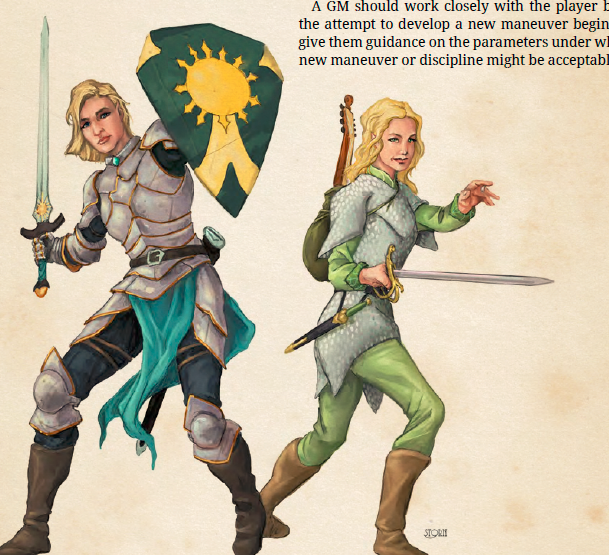
Libertad's Thoughts: This chapter contains a lot of information you'll already be familiar with, but it's a necessary read in that it takes about some minor details not included in the rest of the book.
Next time we're covering The Art of the Blade, which details all the maneuvers and stances. It's a doozy of a chapter, covering 89 of the book's 165 pages. For that reason I'm going to cover it in parts.
The Art of the Blade: Black Seraph and Broken Blade
Original SA post
Chapter Four, Part One: The Art of the Blade
This is where we look at all the maneuvers and stances up close. As there are about thirty-something maneuvers/stances per discipline, I'm not going to detail them all individually, instead grouping related ones together and pointing out interesting ones.
Much like spells, maneuvers and stances are labeled 1st through 9th in level. There are several maneuvers (around usually 3-4) to gain at each "level," although there is only one special 9th-level maneuver for each discipline.
Black Seraph is our first discipline. It's a brutal art which focuses on charge attacks, pain-related debuffs, and evil and unholy-themed attacks (many of which bear the [Evil] descriptor and/or inflict profane damage). All Black Seraph maneuvers are considered supernatural abilities, and in order to learn the techniques one must take the Martial Training feats or join the Black Thorn Knights martial tradition and swap out one of your class' disciplines in exchange for this one.
Several maneuvers (Voracious Drive at 1st, Voracious Drive at 3rd, Abyssal Drive at 6th, and Charge of the Ravager at 7th) allow the user to make a charge attack without provoking an attack of opportunity plus an additional effect, such as additional damage, sickening an opponent (Abyssal Drive), or making one bonus attack to every opponent within reach of your charge path (Charge of the Ravager).
Low level maneuvers (1 to 3) include such abilities as Gut Strike (strike plus sickened condition on opponent on a failed save), Ravaging Blow (strike fills the enemy with fear on a failed save), Fear Eating Technique (boost restores hit points to user upon successful demoralization of opponent), Intimidating Force (counter with successful Intimidate check vs. attack roll to negate enemy attack), Shadow Feather Strike (strike manifests dark feather-shaped energy which is thrown as a ranged touch attack), and Tendon Rip (strike deals damage plus halved movement equal to initiator modifier in rounds). Stances include Black Seraph's Glare (demoralize as free action against enemies you damaged that round), Savage Stance (+1d8 damage but -2 to attack rolls), and Black Seraph Battle Stance (channel the might of the lower planes grants unholy property to weapons plus constant magic circle against good on self).
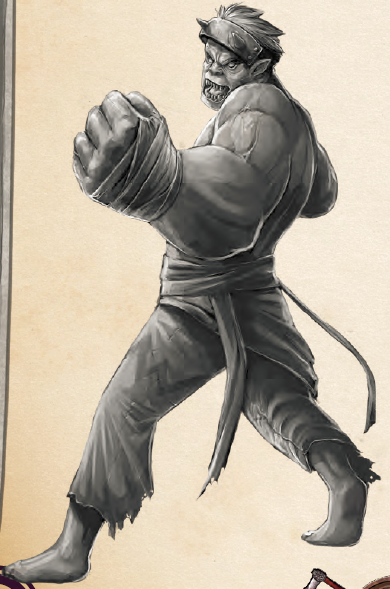
Middle level maneuvers (4-6) include get such dark gems as Circle of Razor Feathers (hold weapon up to sky to shower opponents with needles in an Area of Effect attack), Abyssal Lance (strike summons a lance of pure rage to throw at opponent and stun for 1 round on failed save due to wracking pain), Sensory Rip (strike scars the opponent's eyes to blind them on a failed save), and Black Seraph's Wrath (boost adds Intimidate check result to next melee damage). Stances include Walk in the Dark (surrounded by constant darkness and gain darkvision) and Razor Wings of the Black Seraph (form an ethereal image of a fallen angel to gain fly speed, AC bonus, and Whirlwind Attack feat).
The high-tier end (7-8) includes Armageddon Lance (strike like Abyssal Lance, but stronger and panics opponents and deals hp damage to user), Devastating Riposte (counter calls for opposed Intimidate check vs. attack roll, inflicting melee attack + 8d6 damage if successful), Apocalyptic Strike (strike sends shockwaves through the ground to perform an Area of Effect attack and inflict daze on a failed save), and Void Seraph Strike (strike summons claws and wings to devour opponent, dealing damage over 1d4 rounds plus concealment vs. targeted opponents). The only stance includes Vampiric Aura, where at the end of your turn you deal profone damage to all living creatures within a 20 foot radius and heal a like amount.
The ultimate 9th level maneuver is Black Seraph Onslaught, where he inflicts a full attack plus one additional attack, dealing an extra 4d6 damage per successful hit and nauseates them for a number of rounds equal to the attack. People killed by this maneuver are so mutilated to bits that only True Resurrection can bring them back to life.
Libertad's Thoughts: This an aggressively-minded stance, with little in the way of counters but much in the way of inflicting horrible conditions on your opponent. I really like the flavor as well.
Broken Blade techniques require the user to be using discipline weapons or be unarmed. Use of appropriate weapons in conjunction with damage-dealing maenuvers inflict an additional 2 points of damage. Many maneuvers involve some type of battlefield control, where successful use moves either you or the opponent (or both) a certain number of squares.
Low-level maneuvers (1st to 3rd) include Flurry Strike (strike which allows you to make 2 attacks as a standard action), Pommel Bash (surprise elbow strike targets flat-footed Armor Class and deals 1d6 bonus damage), Bronze Knuckle (boost which boosts unarmed damage by 2d6 and ignores damage reduction), Cartwheel Axe Kick (successful Acrobatics check allows user to move 10 feet towards or away from a target without provoking attacks of opportunity, plus 2d6 bonus damage if successful hit), Leg Sweeping Hilt (strike which allows a trip plus an immediate attack if successful), Flat Iron Riposte (counter which throws an opponent 10 feet away on a successful Acrobatics vs. enemy's attack roll), and Steel Flurry Strike (as Flurry Strike but 3 attacks). Stances include Iron Hand Stance (+2 shield bonus to Armor Class as long as you have one free hand) and Broken Blade Stance (gain bonus equal to initiator level on Acrobatics to avoid attacks of opportunity plus bonus attacks on a full attack).
Mid-level maneuvers (4th to 6th) include Broken Blade Riposte (counter which deals 3d6 bonus damage and moves target 5 feet away if they successfully melee attack you), Iron-Breaking Palm (sunder with 3d6 bonus damage plus entangled if broken item is shield), Iron Monger's Throw (CMB check with +4 bonus to throw opponent 20 feet away and 6d6 points of damage), Shards of Steel Strike (attack deals 8d6 damage plus 2d4 bleed damage for several rounds afterwards), Singing Steel Strike (unarmed strike deals 8d6 bonus damage plus deafens target for 1d4 rounds on failed save), and Steel Axe Kick (unarmed strike deals 10d6 bonus damage and dazes target for 1d3 rounds on failed save). Stances include Steel Grappler's Attitude (treated as one size category larger for grapple/bull rush/etc actions and add initiator modifier to such actions when resisting) and Pit Fighter's Stance (deal 2d6 bonus damage when opponent is denied Dexterity bonus to Armor Class, plus can perform one dirty trick action per round as a swift action).
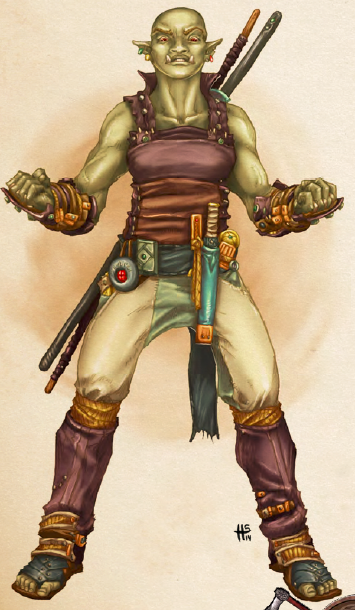
High-level maneuvers (7th and 8th) include Adamantine Knuckle (Boost which ignores hardness of objects and 6d6 bonus damage to all attacks within the round), Spinning Flurry Rush (make 2 attacks against each enemy within your reach as standard action, each attack deals 4d6 bonus damage), Meteoric Throw (can hurl opponent within 25 feet as ranged touch attack dealing 12d6 damage, can be thrown at other opponents and deal damage to them too!), and Spinning Adamantine Axe (one unarmed attack against every foe within reach and 10d6 bonus damage which knocks targets prone and ignores damage reduction). The only stance is Unbreakable Stride Stance, which grants a continual freedom of movement spell effect on the user.
The ultimate 9th-level maneuver is Storm of Iron Fists Strike. The user makes a full attack and each strikes deals 4d6 bonus damage. Afterwards the target must make a Fortitude save (with a higher DC the more successful attacks land) or be reduced to -1 hit points.
Libertad's Thoughts: This really is what the Monk class should have been. There's a lot of ways to crank up the bonus damage and move yourself and opponents around the battle grid to line them up for your fellow party members. The "flurry" maneuvers are pretty much a better Flurry of Blows because they're all standard actions meaning that you can move and attack multiple times in the same round.
Next time we'll cover Golden Lion, Iron Tortoise, and possibly Primal Fury.
The Art of the Blade: Golden Lion
Original SA post
Anyway, I'm doing an alternate thing for the disciplines: I make a post as soon as I finish a discipline. For this post, we have Golden Lion.
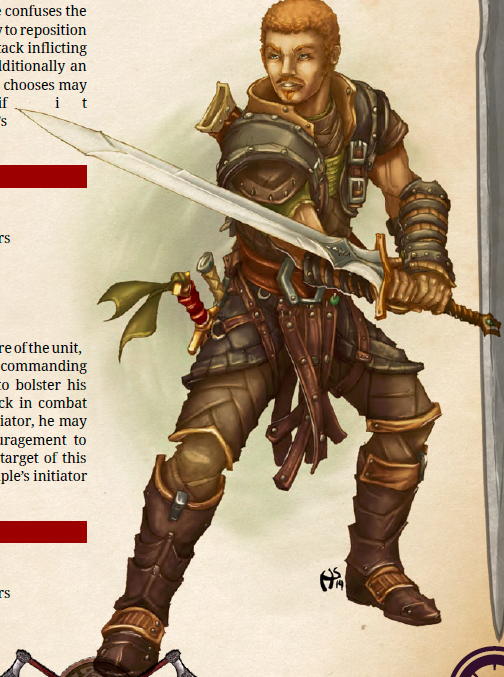
Golden Lion is the White Raven of Path of War, meaning that its true effectiveness is greatest when you have fighting alongside you. A good portion of the maneuvers are predicated around granting additional actions and special abilities, bonuses based on adjacent allies, stuff like that.
Low-level maneuvers (1 to 3) include Demoralizing Roar (boost which imposes the shaken condition on one target), Hunting Party (strike which grants an adjacent ally an attack of opportunity to target you just hit), Tactical Strike (strike which grants free 10 foot movement to ally within 10 feet), Defending the Pride (boost which grants +4 morale bonus to AC to allies within 60 feet), Warning Roar (counter which negates an attack on an ally by Diplomacy vs. attack roll, very useful maneuver!), and Pack Pounce (strike deals +5 bonus damage for every adjacent ally, +15 max). Stances include Pride Leader's Stance (by acting like a proud lion you grant allies +4 on saves vs. fear and demoralization) and Golden Commander Stance (can grant flanking benefits to opponents engaged in melee with the same opponent, perfect for Sneak Attackers).
Mid-level maneuvers (4 to 6) include Charge of the Battle Cat (charge attack deals 4d6 additional damage and knocks foe prone on failed save), Direct the Pride (boost allows a single ally to act immediately as though their initiative was 1 lower than user, then reverts back on following round), Golden Swipe (strike deals 6d6 damage and forces target to move 10 feet, can provoke attacks of opportunity), Discipline of the Pride (grant combat feat user knows to an ally within 30 feet for 3 rounds, can only benefit 1 at a time), Strategic Blow (strike deals 8d6 damage, ally within 10 feet may make a move action as though it were a free action), and Endurance of the Strong (counter which restores 2x initiator level in hit points to ally just struck in combat). Stances include Golden Lion Charger (+2 on attacks when charging does not provoke attack of opportunity when charging) and Golden General's Attitude (grants allies +1 attack and damage rolls and saves vs. fear per 4 initiator levels).
High-level maneuvers (7 and 8) include Orichalcum Swipe (much like the other mineral swipe maneuvers, strike inflicts 12d6 damage and target must move up to twice base speed and provokes attacks of opportunity), War Lion's Charge (strike deals 14d6 bonus damage on a charge and stuns opponent on failed save), Alpha's Roar (boost is an awesome cry for victory which grant allies +4 morale bonus on saves and an equal increase to the save DC of their special attacks and spells), and Lion Lord's Agony (strike does not deal standard damage, but instead damage equal to initiator's max hit points minus their current hit points, plus foe is shaken for 1 round on a failed save). The stance includes Triumphant Lion's Leadership (initiator and any allies gain +1d6 damage for every foe initiator has slain while the stance is in effect, maximum +5d6).
The ultimate 9th-level maneuver is Lord of the Pridelands, a boost which grants the initiator and all his allies within 60 feet a +2 morale bonus on attack, damage, Armor Class, and saving throws for one round (maximum +10 bonus).
Libertad's Thoughts: I can see a lot of powerful combinations and uses for a Golden Lion user in just about any party. It's a really good discipline.